BUS226: Research Report: Selection Tools for Gallery Assistant Role
VerifiedAdded on 2023/01/17
|19
|4187
|46
Report
AI Summary
This research report, prepared for BUS226, delves into the critical aspects of talent acquisition, specifically focusing on the selection process. The report begins with an executive summary and table of contents, providing a clear roadmap for the discussion. It emphasizes the importance of selecting the right candidate from a pool of applicants, highlighting the challenges faced by Human Resource departments. The report examines the selection process from an HR perspective, emphasizing the strategic planning of recruitment, evaluation, and hiring. It then explores various tools used for selection, with a detailed analysis of interviews and psychometric assessments. The discussion includes the benefits and limitations of each tool, alongside recommendations for improving the selection process, such as structured interviews and pre-defined job descriptions. The report culminates in a recommendation for a Gallery Assistant role, suggesting a combination of structured interviews and psychometric assessments, along with a sample questionnaire schedule. The report is well-structured, providing a comprehensive understanding of selection methods and their relevance in human resource management.
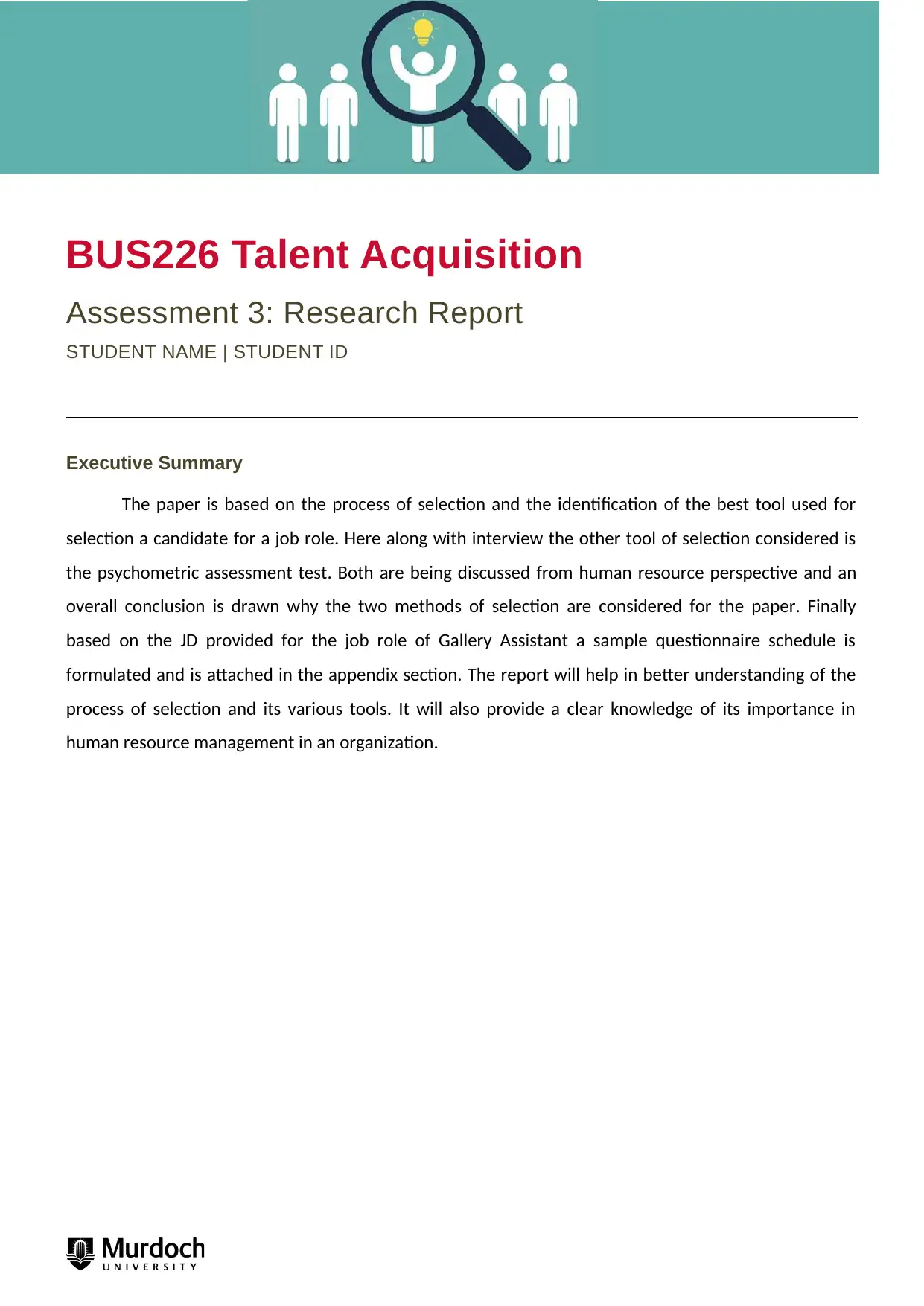
BUS226 Talent Acquisition
Assessment 3: Research Report
STUDENT NAME | STUDENT ID
Executive Summary
The paper is based on the process of selection and the identification of the best tool used for
selection a candidate for a job role. Here along with interview the other tool of selection considered is
the psychometric assessment test. Both are being discussed from human resource perspective and an
overall conclusion is drawn why the two methods of selection are considered for the paper. Finally
based on the JD provided for the job role of Gallery Assistant a sample questionnaire schedule is
formulated and is attached in the appendix section. The report will help in better understanding of the
process of selection and its various tools. It will also provide a clear knowledge of its importance in
human resource management in an organization.
Assessment 3: Research Report
STUDENT NAME | STUDENT ID
Executive Summary
The paper is based on the process of selection and the identification of the best tool used for
selection a candidate for a job role. Here along with interview the other tool of selection considered is
the psychometric assessment test. Both are being discussed from human resource perspective and an
overall conclusion is drawn why the two methods of selection are considered for the paper. Finally
based on the JD provided for the job role of Gallery Assistant a sample questionnaire schedule is
formulated and is attached in the appendix section. The report will help in better understanding of the
process of selection and its various tools. It will also provide a clear knowledge of its importance in
human resource management in an organization.
Paraphrase This Document
Need a fresh take? Get an instant paraphrase of this document with our AI Paraphraser
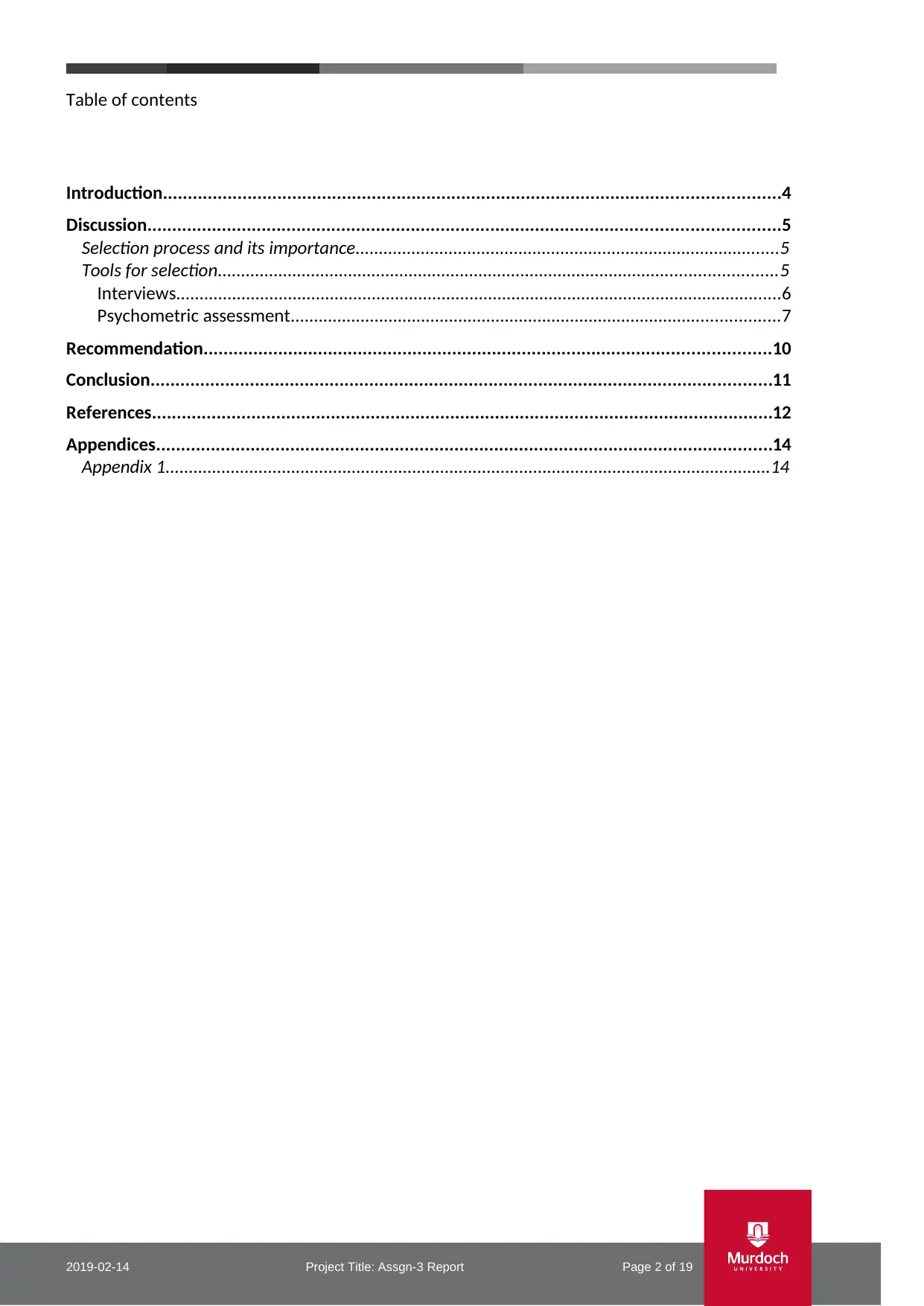
Table of contents
Introduction............................................................................................................................4
Discussion...............................................................................................................................5
Selection process and its importance...........................................................................................5
Tools for selection........................................................................................................................5
Interviews..................................................................................................................................6
Psychometric assessment.........................................................................................................7
Recommendation..................................................................................................................10
Conclusion.............................................................................................................................11
References.............................................................................................................................12
Appendices............................................................................................................................14
Appendix 1..................................................................................................................................14
2019-02-14 Project Title: Assgn-3 Report Page 2 of 19
Introduction............................................................................................................................4
Discussion...............................................................................................................................5
Selection process and its importance...........................................................................................5
Tools for selection........................................................................................................................5
Interviews..................................................................................................................................6
Psychometric assessment.........................................................................................................7
Recommendation..................................................................................................................10
Conclusion.............................................................................................................................11
References.............................................................................................................................12
Appendices............................................................................................................................14
Appendix 1..................................................................................................................................14
2019-02-14 Project Title: Assgn-3 Report Page 2 of 19
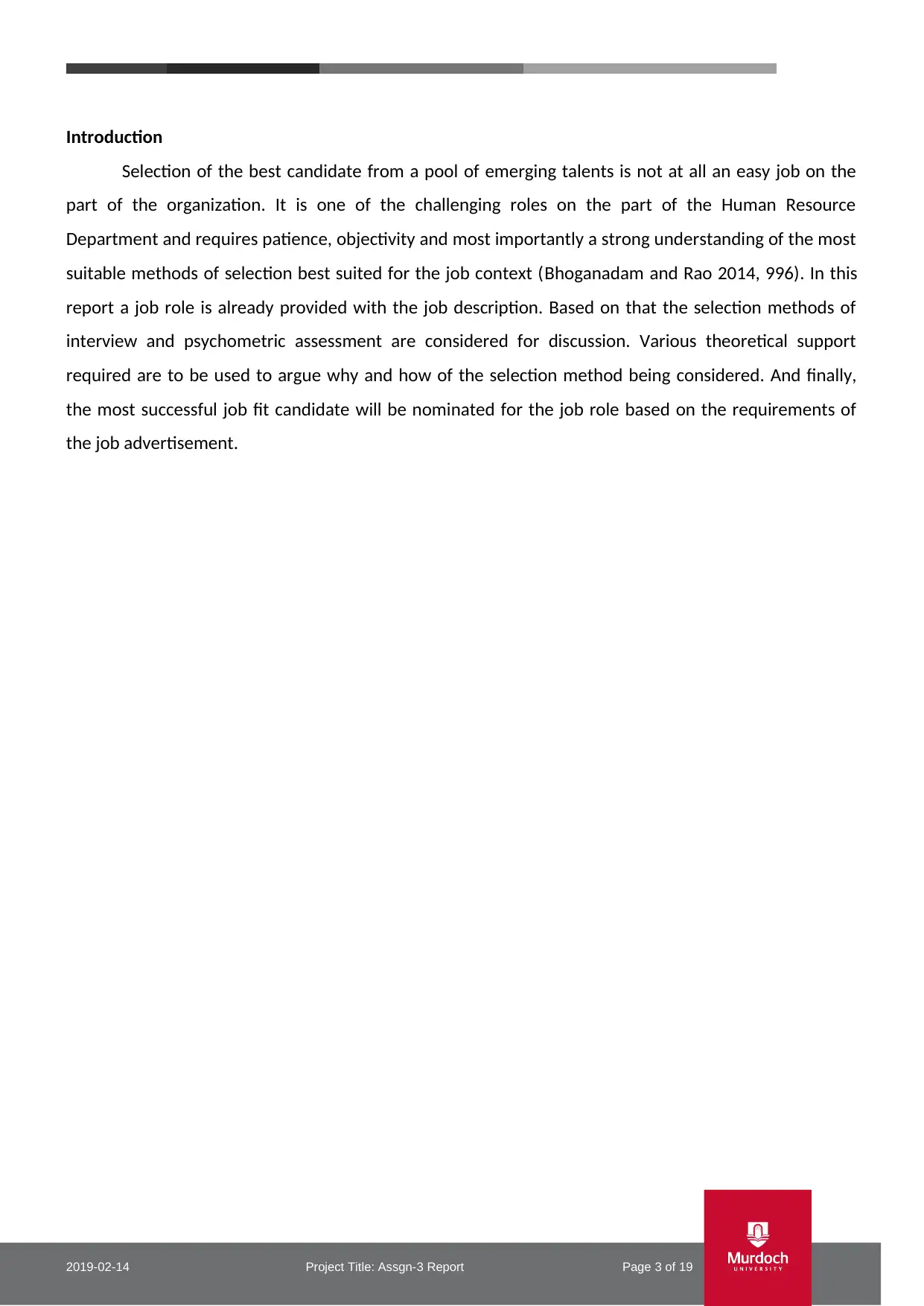
Introduction
Selection of the best candidate from a pool of emerging talents is not at all an easy job on the
part of the organization. It is one of the challenging roles on the part of the Human Resource
Department and requires patience, objectivity and most importantly a strong understanding of the most
suitable methods of selection best suited for the job context (Bhoganadam and Rao 2014, 996). In this
report a job role is already provided with the job description. Based on that the selection methods of
interview and psychometric assessment are considered for discussion. Various theoretical support
required are to be used to argue why and how of the selection method being considered. And finally,
the most successful job fit candidate will be nominated for the job role based on the requirements of
the job advertisement.
2019-02-14 Project Title: Assgn-3 Report Page 3 of 19
Selection of the best candidate from a pool of emerging talents is not at all an easy job on the
part of the organization. It is one of the challenging roles on the part of the Human Resource
Department and requires patience, objectivity and most importantly a strong understanding of the most
suitable methods of selection best suited for the job context (Bhoganadam and Rao 2014, 996). In this
report a job role is already provided with the job description. Based on that the selection methods of
interview and psychometric assessment are considered for discussion. Various theoretical support
required are to be used to argue why and how of the selection method being considered. And finally,
the most successful job fit candidate will be nominated for the job role based on the requirements of
the job advertisement.
2019-02-14 Project Title: Assgn-3 Report Page 3 of 19
⊘ This is a preview!⊘
Do you want full access?
Subscribe today to unlock all pages.

Trusted by 1+ million students worldwide
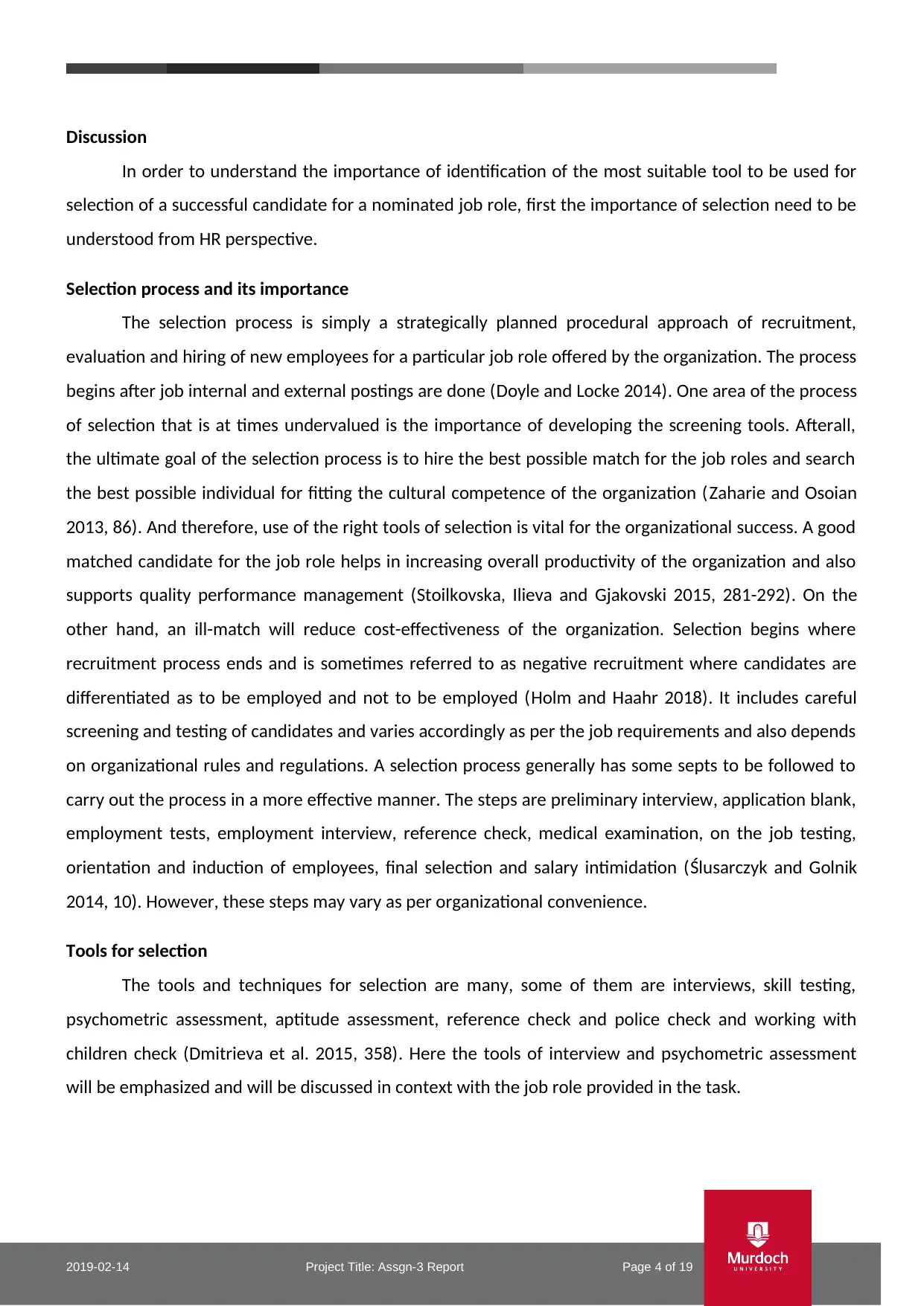
Discussion
In order to understand the importance of identification of the most suitable tool to be used for
selection of a successful candidate for a nominated job role, first the importance of selection need to be
understood from HR perspective.
Selection process and its importance
The selection process is simply a strategically planned procedural approach of recruitment,
evaluation and hiring of new employees for a particular job role offered by the organization. The process
begins after job internal and external postings are done (Doyle and Locke 2014). One area of the process
of selection that is at times undervalued is the importance of developing the screening tools. Afterall,
the ultimate goal of the selection process is to hire the best possible match for the job roles and search
the best possible individual for fitting the cultural competence of the organization (Zaharie and Osoian
2013, 86). And therefore, use of the right tools of selection is vital for the organizational success. A good
matched candidate for the job role helps in increasing overall productivity of the organization and also
supports quality performance management (Stoilkovska, Ilieva and Gjakovski 2015, 281-292). On the
other hand, an ill-match will reduce cost-effectiveness of the organization. Selection begins where
recruitment process ends and is sometimes referred to as negative recruitment where candidates are
differentiated as to be employed and not to be employed (Holm and Haahr 2018). It includes careful
screening and testing of candidates and varies accordingly as per the job requirements and also depends
on organizational rules and regulations. A selection process generally has some septs to be followed to
carry out the process in a more effective manner. The steps are preliminary interview, application blank,
employment tests, employment interview, reference check, medical examination, on the job testing,
orientation and induction of employees, final selection and salary intimidation (Ślusarczyk and Golnik
2014, 10). However, these steps may vary as per organizational convenience.
Tools for selection
The tools and techniques for selection are many, some of them are interviews, skill testing,
psychometric assessment, aptitude assessment, reference check and police check and working with
children check (Dmitrieva et al. 2015, 358). Here the tools of interview and psychometric assessment
will be emphasized and will be discussed in context with the job role provided in the task.
2019-02-14 Project Title: Assgn-3 Report Page 4 of 19
In order to understand the importance of identification of the most suitable tool to be used for
selection of a successful candidate for a nominated job role, first the importance of selection need to be
understood from HR perspective.
Selection process and its importance
The selection process is simply a strategically planned procedural approach of recruitment,
evaluation and hiring of new employees for a particular job role offered by the organization. The process
begins after job internal and external postings are done (Doyle and Locke 2014). One area of the process
of selection that is at times undervalued is the importance of developing the screening tools. Afterall,
the ultimate goal of the selection process is to hire the best possible match for the job roles and search
the best possible individual for fitting the cultural competence of the organization (Zaharie and Osoian
2013, 86). And therefore, use of the right tools of selection is vital for the organizational success. A good
matched candidate for the job role helps in increasing overall productivity of the organization and also
supports quality performance management (Stoilkovska, Ilieva and Gjakovski 2015, 281-292). On the
other hand, an ill-match will reduce cost-effectiveness of the organization. Selection begins where
recruitment process ends and is sometimes referred to as negative recruitment where candidates are
differentiated as to be employed and not to be employed (Holm and Haahr 2018). It includes careful
screening and testing of candidates and varies accordingly as per the job requirements and also depends
on organizational rules and regulations. A selection process generally has some septs to be followed to
carry out the process in a more effective manner. The steps are preliminary interview, application blank,
employment tests, employment interview, reference check, medical examination, on the job testing,
orientation and induction of employees, final selection and salary intimidation (Ślusarczyk and Golnik
2014, 10). However, these steps may vary as per organizational convenience.
Tools for selection
The tools and techniques for selection are many, some of them are interviews, skill testing,
psychometric assessment, aptitude assessment, reference check and police check and working with
children check (Dmitrieva et al. 2015, 358). Here the tools of interview and psychometric assessment
will be emphasized and will be discussed in context with the job role provided in the task.
2019-02-14 Project Title: Assgn-3 Report Page 4 of 19
Paraphrase This Document
Need a fresh take? Get an instant paraphrase of this document with our AI Paraphraser

Interviews
Interviews can be preliminary and employment interviews. It can be telephonic and direct too. It can
also be structured and semi-structured ones. Interview is more rigorous than screening and help in
better determination of the candidate fitness for the position being offered (Sinha and Thaly 2013, 141-
156). The process of interview helps the organization in determining validity, reliability and fairness of
the applicants for the job role. Interview process is the most flexible and practical and can be used
throughout the selection process at any stage. Interview is an opportunity given to the candidate to
create a good impression of theirs in front of the employer (Glodstein 2014, 14). Execution of interview
is though full of diversities yet it helps in better evaluation of the candidate. Diversity can be in terms of
duration, structure, questioning style, content and data collection methods. In some interviews the
interviewer is seen as a participant observer only and in some verbal psychometric analysis is done.
Among all the types of interviews the structured interviews are the most effective ones and have limited
biasness and judgement (Walker et al. 2013, 1325-1347). The credentials mentioned in the applicant’s
resume are probed in a deeper manner by the help of the method of interview and other additional or
missing information related to the candidate are also collected during the process of interview (Holmes
2013, 538-554).
However, interview has certain limitations like low inter-rater reliability, errors, talkative nature of
interviewer, variance in questions being asked and other issues like tricky questions, irrelevant questions
etc. (Chow and Chapman 2013, 91-94). In order to reduce such limitations, the following methods need
to be adopted to increase value of the selection process.
Structured interview guides will increase reliability of interview questions
A complete framework of job description and job specifications need to be provided to the
candidate before-hand so that biasness of actual requirement is reduced at large.
Proper training on the part of the interviewer is also required where the interviewer should
know the ethical prospects of a fair interview process. For interviewing women and minorities,
the interviewer needs to have special instruction of carrying out the interview process.
Also, errors in interviewing like central tendency error of rating most of the candidates as average,
leniency errors, strictness errors, halo effects, contrast effects and stereotyping of candidates should be
avoided greatly (EG Bateson et al. 2014, 418-433). But in spite of these limitations the process is very
effective and has good test-retest reliability and also have good internal consistency reliability. A typical
interview process consists of prescreening, telephonic interview, face-to-face interview, qualifying
questions and final candidate evaluation (Levashina et al. 2014, 241-293).
2019-02-14 Project Title: Assgn-3 Report Page 5 of 19
Interviews can be preliminary and employment interviews. It can be telephonic and direct too. It can
also be structured and semi-structured ones. Interview is more rigorous than screening and help in
better determination of the candidate fitness for the position being offered (Sinha and Thaly 2013, 141-
156). The process of interview helps the organization in determining validity, reliability and fairness of
the applicants for the job role. Interview process is the most flexible and practical and can be used
throughout the selection process at any stage. Interview is an opportunity given to the candidate to
create a good impression of theirs in front of the employer (Glodstein 2014, 14). Execution of interview
is though full of diversities yet it helps in better evaluation of the candidate. Diversity can be in terms of
duration, structure, questioning style, content and data collection methods. In some interviews the
interviewer is seen as a participant observer only and in some verbal psychometric analysis is done.
Among all the types of interviews the structured interviews are the most effective ones and have limited
biasness and judgement (Walker et al. 2013, 1325-1347). The credentials mentioned in the applicant’s
resume are probed in a deeper manner by the help of the method of interview and other additional or
missing information related to the candidate are also collected during the process of interview (Holmes
2013, 538-554).
However, interview has certain limitations like low inter-rater reliability, errors, talkative nature of
interviewer, variance in questions being asked and other issues like tricky questions, irrelevant questions
etc. (Chow and Chapman 2013, 91-94). In order to reduce such limitations, the following methods need
to be adopted to increase value of the selection process.
Structured interview guides will increase reliability of interview questions
A complete framework of job description and job specifications need to be provided to the
candidate before-hand so that biasness of actual requirement is reduced at large.
Proper training on the part of the interviewer is also required where the interviewer should
know the ethical prospects of a fair interview process. For interviewing women and minorities,
the interviewer needs to have special instruction of carrying out the interview process.
Also, errors in interviewing like central tendency error of rating most of the candidates as average,
leniency errors, strictness errors, halo effects, contrast effects and stereotyping of candidates should be
avoided greatly (EG Bateson et al. 2014, 418-433). But in spite of these limitations the process is very
effective and has good test-retest reliability and also have good internal consistency reliability. A typical
interview process consists of prescreening, telephonic interview, face-to-face interview, qualifying
questions and final candidate evaluation (Levashina et al. 2014, 241-293).
2019-02-14 Project Title: Assgn-3 Report Page 5 of 19
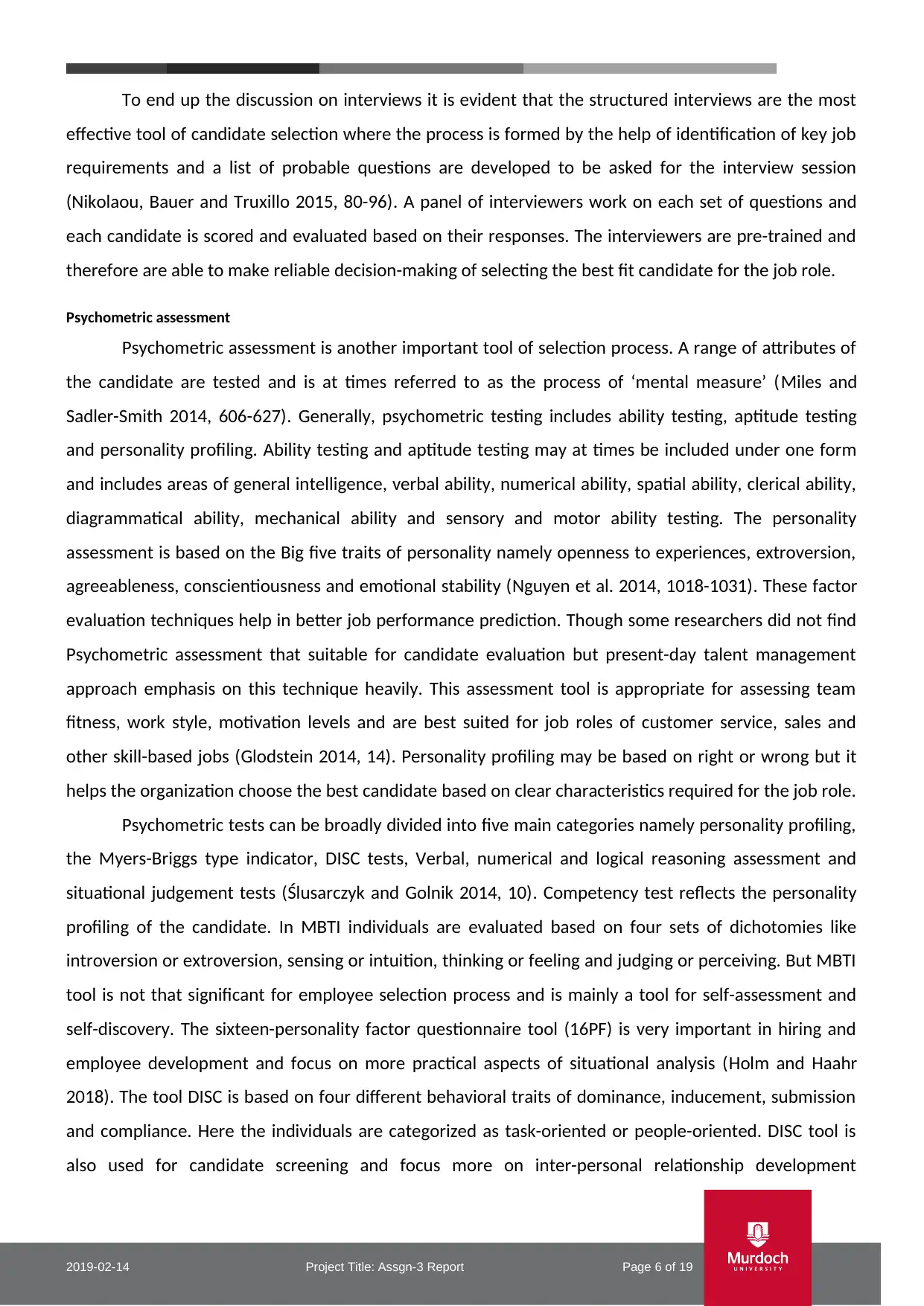
To end up the discussion on interviews it is evident that the structured interviews are the most
effective tool of candidate selection where the process is formed by the help of identification of key job
requirements and a list of probable questions are developed to be asked for the interview session
(Nikolaou, Bauer and Truxillo 2015, 80-96). A panel of interviewers work on each set of questions and
each candidate is scored and evaluated based on their responses. The interviewers are pre-trained and
therefore are able to make reliable decision-making of selecting the best fit candidate for the job role.
Psychometric assessment
Psychometric assessment is another important tool of selection process. A range of attributes of
the candidate are tested and is at times referred to as the process of ‘mental measure’ (Miles and
Sadler-Smith 2014, 606-627). Generally, psychometric testing includes ability testing, aptitude testing
and personality profiling. Ability testing and aptitude testing may at times be included under one form
and includes areas of general intelligence, verbal ability, numerical ability, spatial ability, clerical ability,
diagrammatical ability, mechanical ability and sensory and motor ability testing. The personality
assessment is based on the Big five traits of personality namely openness to experiences, extroversion,
agreeableness, conscientiousness and emotional stability (Nguyen et al. 2014, 1018-1031). These factor
evaluation techniques help in better job performance prediction. Though some researchers did not find
Psychometric assessment that suitable for candidate evaluation but present-day talent management
approach emphasis on this technique heavily. This assessment tool is appropriate for assessing team
fitness, work style, motivation levels and are best suited for job roles of customer service, sales and
other skill-based jobs (Glodstein 2014, 14). Personality profiling may be based on right or wrong but it
helps the organization choose the best candidate based on clear characteristics required for the job role.
Psychometric tests can be broadly divided into five main categories namely personality profiling,
the Myers-Briggs type indicator, DISC tests, Verbal, numerical and logical reasoning assessment and
situational judgement tests (Ślusarczyk and Golnik 2014, 10). Competency test reflects the personality
profiling of the candidate. In MBTI individuals are evaluated based on four sets of dichotomies like
introversion or extroversion, sensing or intuition, thinking or feeling and judging or perceiving. But MBTI
tool is not that significant for employee selection process and is mainly a tool for self-assessment and
self-discovery. The sixteen-personality factor questionnaire tool (16PF) is very important in hiring and
employee development and focus on more practical aspects of situational analysis (Holm and Haahr
2018). The tool DISC is based on four different behavioral traits of dominance, inducement, submission
and compliance. Here the individuals are categorized as task-oriented or people-oriented. DISC tool is
also used for candidate screening and focus more on inter-personal relationship development
2019-02-14 Project Title: Assgn-3 Report Page 6 of 19
effective tool of candidate selection where the process is formed by the help of identification of key job
requirements and a list of probable questions are developed to be asked for the interview session
(Nikolaou, Bauer and Truxillo 2015, 80-96). A panel of interviewers work on each set of questions and
each candidate is scored and evaluated based on their responses. The interviewers are pre-trained and
therefore are able to make reliable decision-making of selecting the best fit candidate for the job role.
Psychometric assessment
Psychometric assessment is another important tool of selection process. A range of attributes of
the candidate are tested and is at times referred to as the process of ‘mental measure’ (Miles and
Sadler-Smith 2014, 606-627). Generally, psychometric testing includes ability testing, aptitude testing
and personality profiling. Ability testing and aptitude testing may at times be included under one form
and includes areas of general intelligence, verbal ability, numerical ability, spatial ability, clerical ability,
diagrammatical ability, mechanical ability and sensory and motor ability testing. The personality
assessment is based on the Big five traits of personality namely openness to experiences, extroversion,
agreeableness, conscientiousness and emotional stability (Nguyen et al. 2014, 1018-1031). These factor
evaluation techniques help in better job performance prediction. Though some researchers did not find
Psychometric assessment that suitable for candidate evaluation but present-day talent management
approach emphasis on this technique heavily. This assessment tool is appropriate for assessing team
fitness, work style, motivation levels and are best suited for job roles of customer service, sales and
other skill-based jobs (Glodstein 2014, 14). Personality profiling may be based on right or wrong but it
helps the organization choose the best candidate based on clear characteristics required for the job role.
Psychometric tests can be broadly divided into five main categories namely personality profiling,
the Myers-Briggs type indicator, DISC tests, Verbal, numerical and logical reasoning assessment and
situational judgement tests (Ślusarczyk and Golnik 2014, 10). Competency test reflects the personality
profiling of the candidate. In MBTI individuals are evaluated based on four sets of dichotomies like
introversion or extroversion, sensing or intuition, thinking or feeling and judging or perceiving. But MBTI
tool is not that significant for employee selection process and is mainly a tool for self-assessment and
self-discovery. The sixteen-personality factor questionnaire tool (16PF) is very important in hiring and
employee development and focus on more practical aspects of situational analysis (Holm and Haahr
2018). The tool DISC is based on four different behavioral traits of dominance, inducement, submission
and compliance. Here the individuals are categorized as task-oriented or people-oriented. DISC tool is
also used for candidate screening and focus more on inter-personal relationship development
2019-02-14 Project Title: Assgn-3 Report Page 6 of 19
⊘ This is a preview!⊘
Do you want full access?
Subscribe today to unlock all pages.

Trusted by 1+ million students worldwide
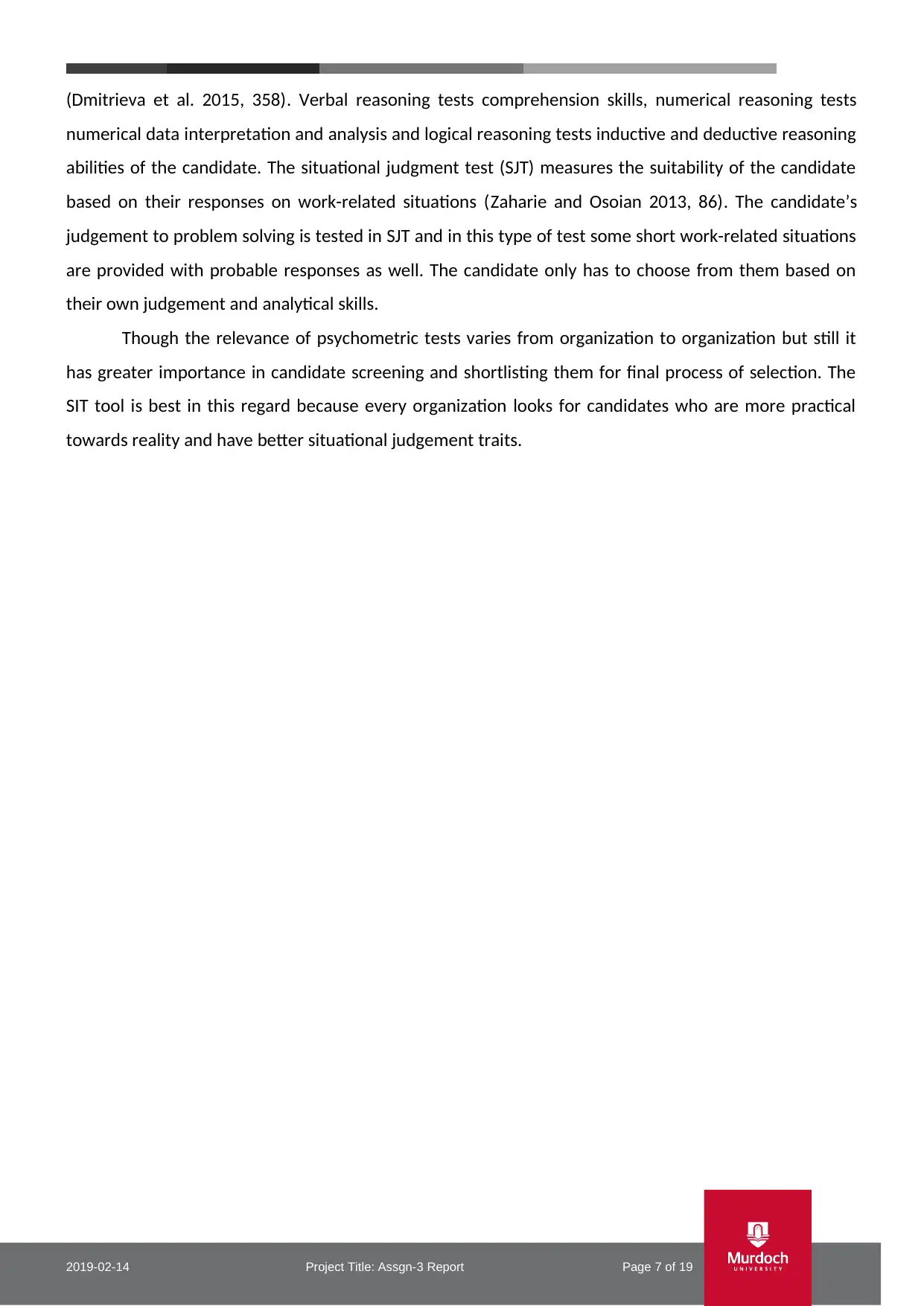
(Dmitrieva et al. 2015, 358). Verbal reasoning tests comprehension skills, numerical reasoning tests
numerical data interpretation and analysis and logical reasoning tests inductive and deductive reasoning
abilities of the candidate. The situational judgment test (SJT) measures the suitability of the candidate
based on their responses on work-related situations (Zaharie and Osoian 2013, 86). The candidate’s
judgement to problem solving is tested in SJT and in this type of test some short work-related situations
are provided with probable responses as well. The candidate only has to choose from them based on
their own judgement and analytical skills.
Though the relevance of psychometric tests varies from organization to organization but still it
has greater importance in candidate screening and shortlisting them for final process of selection. The
SIT tool is best in this regard because every organization looks for candidates who are more practical
towards reality and have better situational judgement traits.
2019-02-14 Project Title: Assgn-3 Report Page 7 of 19
numerical data interpretation and analysis and logical reasoning tests inductive and deductive reasoning
abilities of the candidate. The situational judgment test (SJT) measures the suitability of the candidate
based on their responses on work-related situations (Zaharie and Osoian 2013, 86). The candidate’s
judgement to problem solving is tested in SJT and in this type of test some short work-related situations
are provided with probable responses as well. The candidate only has to choose from them based on
their own judgement and analytical skills.
Though the relevance of psychometric tests varies from organization to organization but still it
has greater importance in candidate screening and shortlisting them for final process of selection. The
SIT tool is best in this regard because every organization looks for candidates who are more practical
towards reality and have better situational judgement traits.
2019-02-14 Project Title: Assgn-3 Report Page 7 of 19
Paraphrase This Document
Need a fresh take? Get an instant paraphrase of this document with our AI Paraphraser
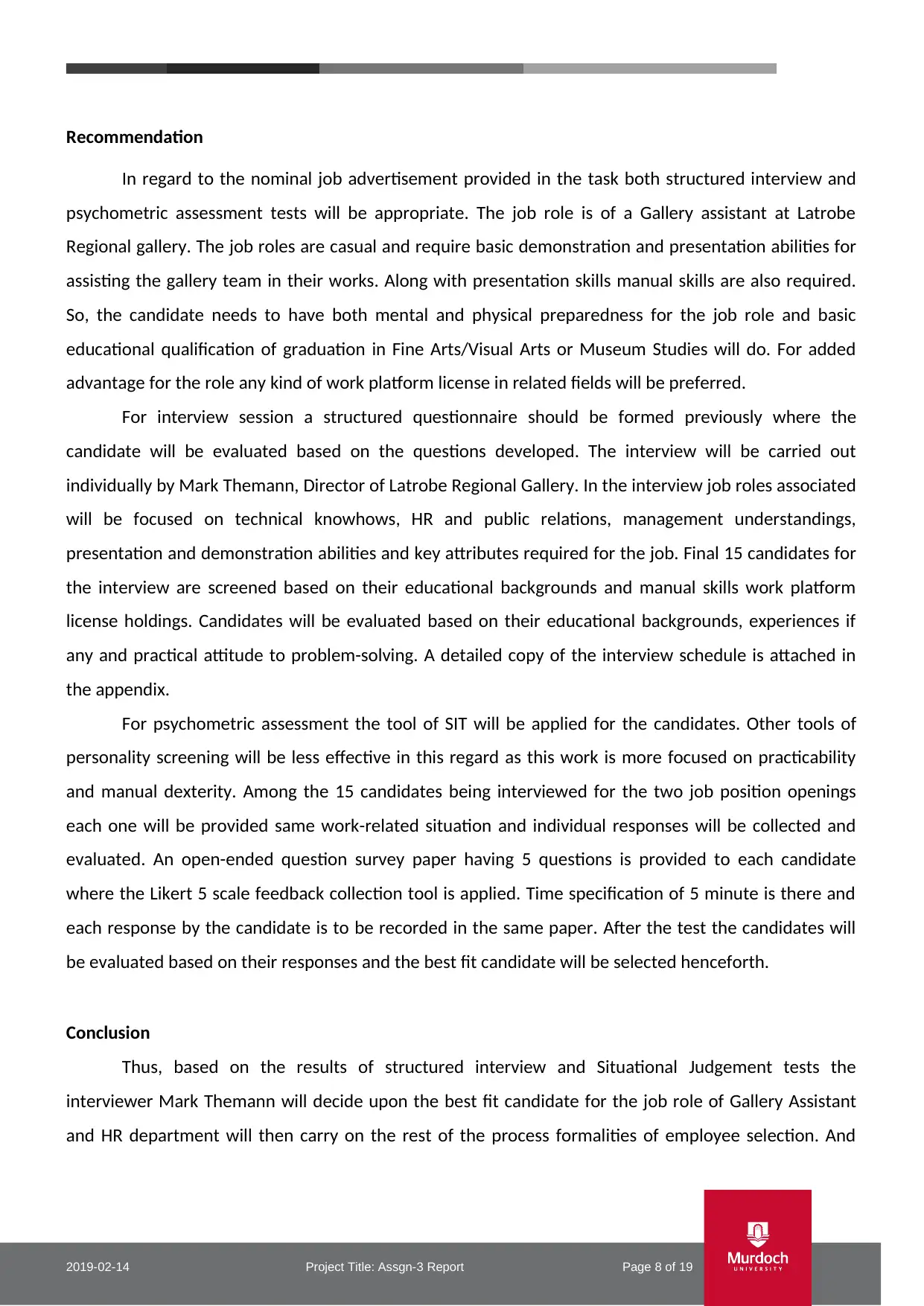
Recommendation
In regard to the nominal job advertisement provided in the task both structured interview and
psychometric assessment tests will be appropriate. The job role is of a Gallery assistant at Latrobe
Regional gallery. The job roles are casual and require basic demonstration and presentation abilities for
assisting the gallery team in their works. Along with presentation skills manual skills are also required.
So, the candidate needs to have both mental and physical preparedness for the job role and basic
educational qualification of graduation in Fine Arts/Visual Arts or Museum Studies will do. For added
advantage for the role any kind of work platform license in related fields will be preferred.
For interview session a structured questionnaire should be formed previously where the
candidate will be evaluated based on the questions developed. The interview will be carried out
individually by Mark Themann, Director of Latrobe Regional Gallery. In the interview job roles associated
will be focused on technical knowhows, HR and public relations, management understandings,
presentation and demonstration abilities and key attributes required for the job. Final 15 candidates for
the interview are screened based on their educational backgrounds and manual skills work platform
license holdings. Candidates will be evaluated based on their educational backgrounds, experiences if
any and practical attitude to problem-solving. A detailed copy of the interview schedule is attached in
the appendix.
For psychometric assessment the tool of SIT will be applied for the candidates. Other tools of
personality screening will be less effective in this regard as this work is more focused on practicability
and manual dexterity. Among the 15 candidates being interviewed for the two job position openings
each one will be provided same work-related situation and individual responses will be collected and
evaluated. An open-ended question survey paper having 5 questions is provided to each candidate
where the Likert 5 scale feedback collection tool is applied. Time specification of 5 minute is there and
each response by the candidate is to be recorded in the same paper. After the test the candidates will
be evaluated based on their responses and the best fit candidate will be selected henceforth.
Conclusion
Thus, based on the results of structured interview and Situational Judgement tests the
interviewer Mark Themann will decide upon the best fit candidate for the job role of Gallery Assistant
and HR department will then carry on the rest of the process formalities of employee selection. And
2019-02-14 Project Title: Assgn-3 Report Page 8 of 19
In regard to the nominal job advertisement provided in the task both structured interview and
psychometric assessment tests will be appropriate. The job role is of a Gallery assistant at Latrobe
Regional gallery. The job roles are casual and require basic demonstration and presentation abilities for
assisting the gallery team in their works. Along with presentation skills manual skills are also required.
So, the candidate needs to have both mental and physical preparedness for the job role and basic
educational qualification of graduation in Fine Arts/Visual Arts or Museum Studies will do. For added
advantage for the role any kind of work platform license in related fields will be preferred.
For interview session a structured questionnaire should be formed previously where the
candidate will be evaluated based on the questions developed. The interview will be carried out
individually by Mark Themann, Director of Latrobe Regional Gallery. In the interview job roles associated
will be focused on technical knowhows, HR and public relations, management understandings,
presentation and demonstration abilities and key attributes required for the job. Final 15 candidates for
the interview are screened based on their educational backgrounds and manual skills work platform
license holdings. Candidates will be evaluated based on their educational backgrounds, experiences if
any and practical attitude to problem-solving. A detailed copy of the interview schedule is attached in
the appendix.
For psychometric assessment the tool of SIT will be applied for the candidates. Other tools of
personality screening will be less effective in this regard as this work is more focused on practicability
and manual dexterity. Among the 15 candidates being interviewed for the two job position openings
each one will be provided same work-related situation and individual responses will be collected and
evaluated. An open-ended question survey paper having 5 questions is provided to each candidate
where the Likert 5 scale feedback collection tool is applied. Time specification of 5 minute is there and
each response by the candidate is to be recorded in the same paper. After the test the candidates will
be evaluated based on their responses and the best fit candidate will be selected henceforth.
Conclusion
Thus, based on the results of structured interview and Situational Judgement tests the
interviewer Mark Themann will decide upon the best fit candidate for the job role of Gallery Assistant
and HR department will then carry on the rest of the process formalities of employee selection. And
2019-02-14 Project Title: Assgn-3 Report Page 8 of 19
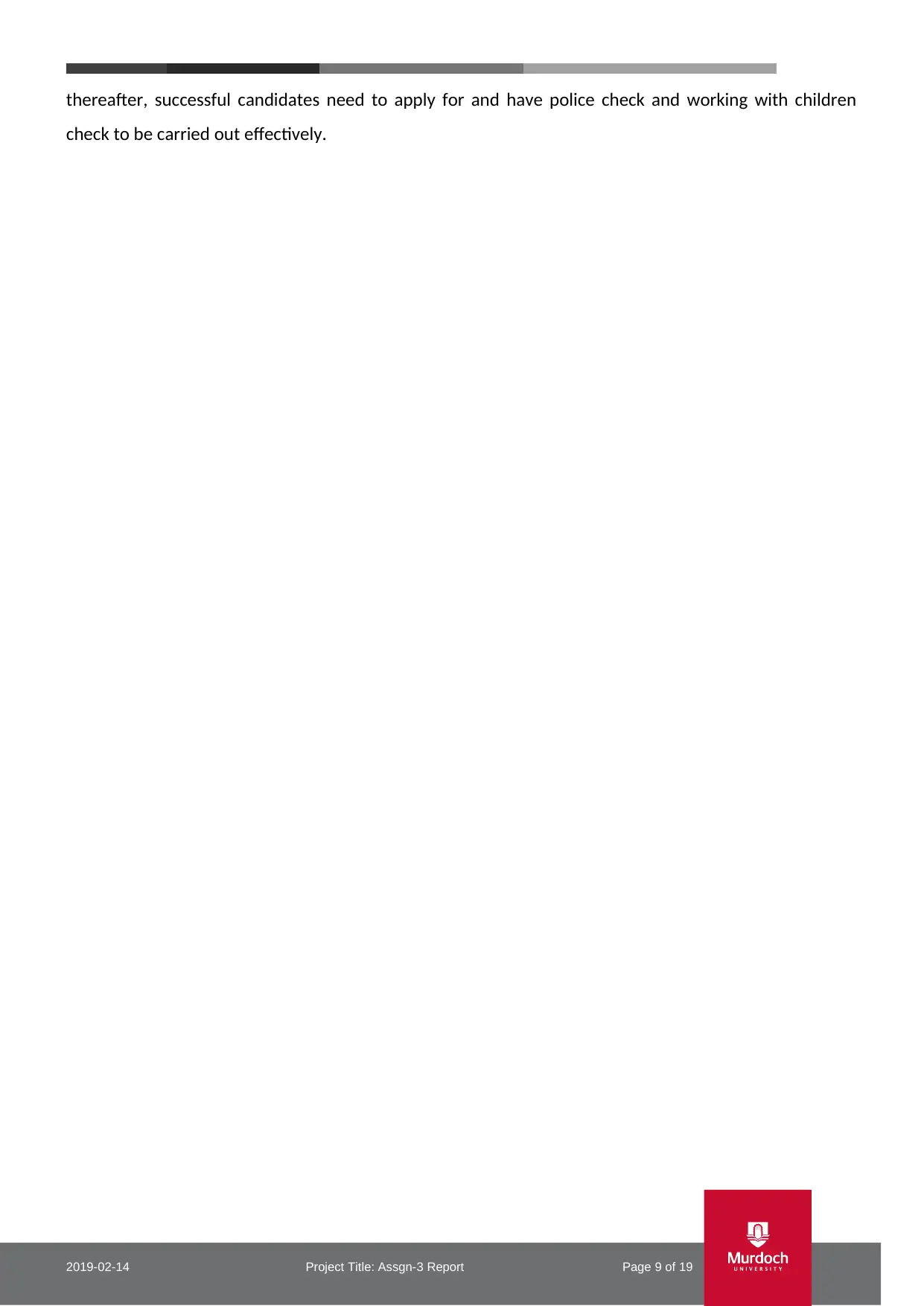
thereafter, successful candidates need to apply for and have police check and working with children
check to be carried out effectively.
2019-02-14 Project Title: Assgn-3 Report Page 9 of 19
check to be carried out effectively.
2019-02-14 Project Title: Assgn-3 Report Page 9 of 19
⊘ This is a preview!⊘
Do you want full access?
Subscribe today to unlock all pages.

Trusted by 1+ million students worldwide
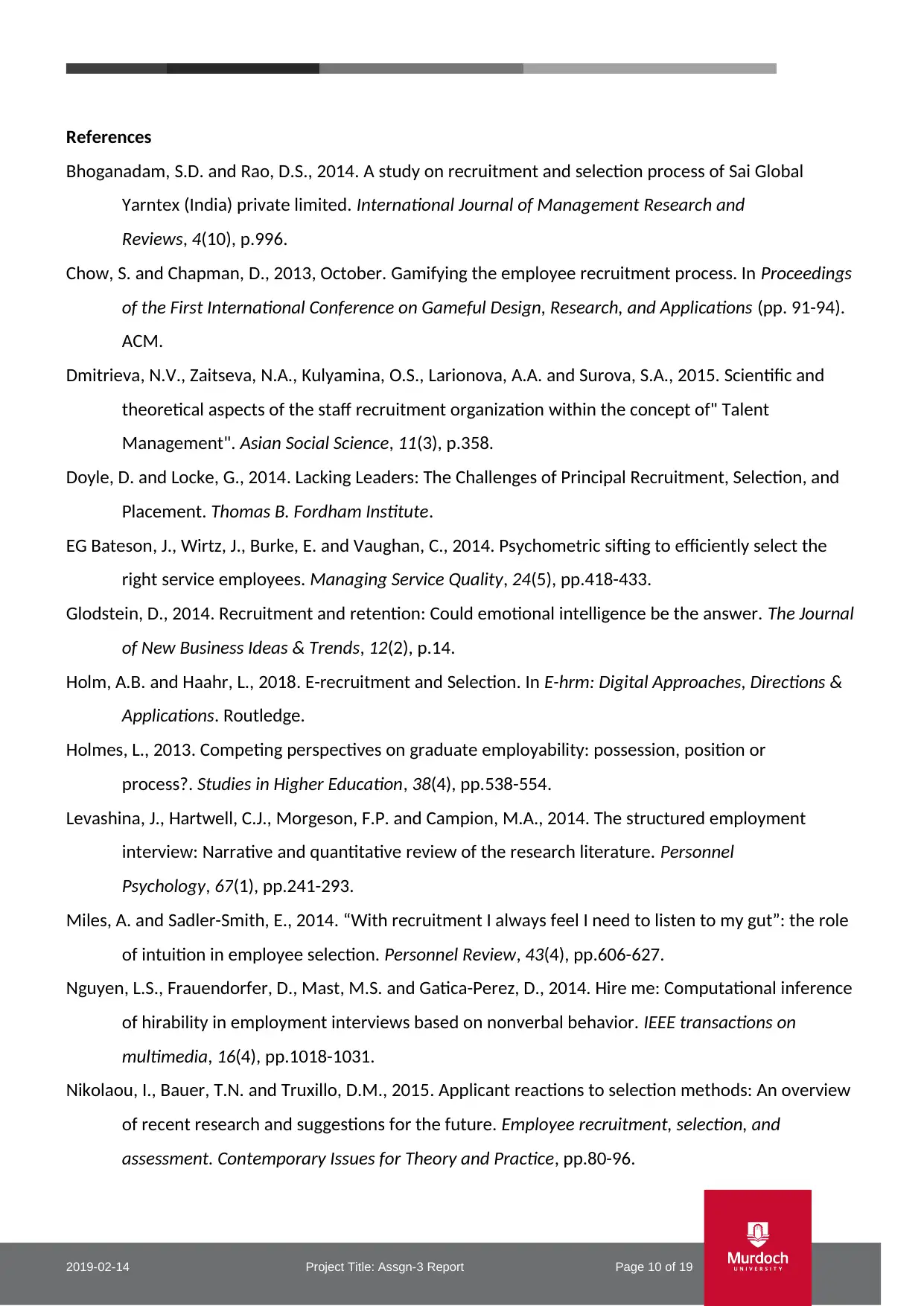
References
Bhoganadam, S.D. and Rao, D.S., 2014. A study on recruitment and selection process of Sai Global
Yarntex (India) private limited. International Journal of Management Research and
Reviews, 4(10), p.996.
Chow, S. and Chapman, D., 2013, October. Gamifying the employee recruitment process. In Proceedings
of the First International Conference on Gameful Design, Research, and Applications (pp. 91-94).
ACM.
Dmitrieva, N.V., Zaitseva, N.A., Kulyamina, O.S., Larionova, A.A. and Surova, S.A., 2015. Scientific and
theoretical aspects of the staff recruitment organization within the concept of" Talent
Management". Asian Social Science, 11(3), p.358.
Doyle, D. and Locke, G., 2014. Lacking Leaders: The Challenges of Principal Recruitment, Selection, and
Placement. Thomas B. Fordham Institute.
EG Bateson, J., Wirtz, J., Burke, E. and Vaughan, C., 2014. Psychometric sifting to efficiently select the
right service employees. Managing Service Quality, 24(5), pp.418-433.
Glodstein, D., 2014. Recruitment and retention: Could emotional intelligence be the answer. The Journal
of New Business Ideas & Trends, 12(2), p.14.
Holm, A.B. and Haahr, L., 2018. E-recruitment and Selection. In E-hrm: Digital Approaches, Directions &
Applications. Routledge.
Holmes, L., 2013. Competing perspectives on graduate employability: possession, position or
process?. Studies in Higher Education, 38(4), pp.538-554.
Levashina, J., Hartwell, C.J., Morgeson, F.P. and Campion, M.A., 2014. The structured employment
interview: Narrative and quantitative review of the research literature. Personnel
Psychology, 67(1), pp.241-293.
Miles, A. and Sadler-Smith, E., 2014. “With recruitment I always feel I need to listen to my gut”: the role
of intuition in employee selection. Personnel Review, 43(4), pp.606-627.
Nguyen, L.S., Frauendorfer, D., Mast, M.S. and Gatica-Perez, D., 2014. Hire me: Computational inference
of hirability in employment interviews based on nonverbal behavior. IEEE transactions on
multimedia, 16(4), pp.1018-1031.
Nikolaou, I., Bauer, T.N. and Truxillo, D.M., 2015. Applicant reactions to selection methods: An overview
of recent research and suggestions for the future. Employee recruitment, selection, and
assessment. Contemporary Issues for Theory and Practice, pp.80-96.
2019-02-14 Project Title: Assgn-3 Report Page 10 of 19
Bhoganadam, S.D. and Rao, D.S., 2014. A study on recruitment and selection process of Sai Global
Yarntex (India) private limited. International Journal of Management Research and
Reviews, 4(10), p.996.
Chow, S. and Chapman, D., 2013, October. Gamifying the employee recruitment process. In Proceedings
of the First International Conference on Gameful Design, Research, and Applications (pp. 91-94).
ACM.
Dmitrieva, N.V., Zaitseva, N.A., Kulyamina, O.S., Larionova, A.A. and Surova, S.A., 2015. Scientific and
theoretical aspects of the staff recruitment organization within the concept of" Talent
Management". Asian Social Science, 11(3), p.358.
Doyle, D. and Locke, G., 2014. Lacking Leaders: The Challenges of Principal Recruitment, Selection, and
Placement. Thomas B. Fordham Institute.
EG Bateson, J., Wirtz, J., Burke, E. and Vaughan, C., 2014. Psychometric sifting to efficiently select the
right service employees. Managing Service Quality, 24(5), pp.418-433.
Glodstein, D., 2014. Recruitment and retention: Could emotional intelligence be the answer. The Journal
of New Business Ideas & Trends, 12(2), p.14.
Holm, A.B. and Haahr, L., 2018. E-recruitment and Selection. In E-hrm: Digital Approaches, Directions &
Applications. Routledge.
Holmes, L., 2013. Competing perspectives on graduate employability: possession, position or
process?. Studies in Higher Education, 38(4), pp.538-554.
Levashina, J., Hartwell, C.J., Morgeson, F.P. and Campion, M.A., 2014. The structured employment
interview: Narrative and quantitative review of the research literature. Personnel
Psychology, 67(1), pp.241-293.
Miles, A. and Sadler-Smith, E., 2014. “With recruitment I always feel I need to listen to my gut”: the role
of intuition in employee selection. Personnel Review, 43(4), pp.606-627.
Nguyen, L.S., Frauendorfer, D., Mast, M.S. and Gatica-Perez, D., 2014. Hire me: Computational inference
of hirability in employment interviews based on nonverbal behavior. IEEE transactions on
multimedia, 16(4), pp.1018-1031.
Nikolaou, I., Bauer, T.N. and Truxillo, D.M., 2015. Applicant reactions to selection methods: An overview
of recent research and suggestions for the future. Employee recruitment, selection, and
assessment. Contemporary Issues for Theory and Practice, pp.80-96.
2019-02-14 Project Title: Assgn-3 Report Page 10 of 19
Paraphrase This Document
Need a fresh take? Get an instant paraphrase of this document with our AI Paraphraser
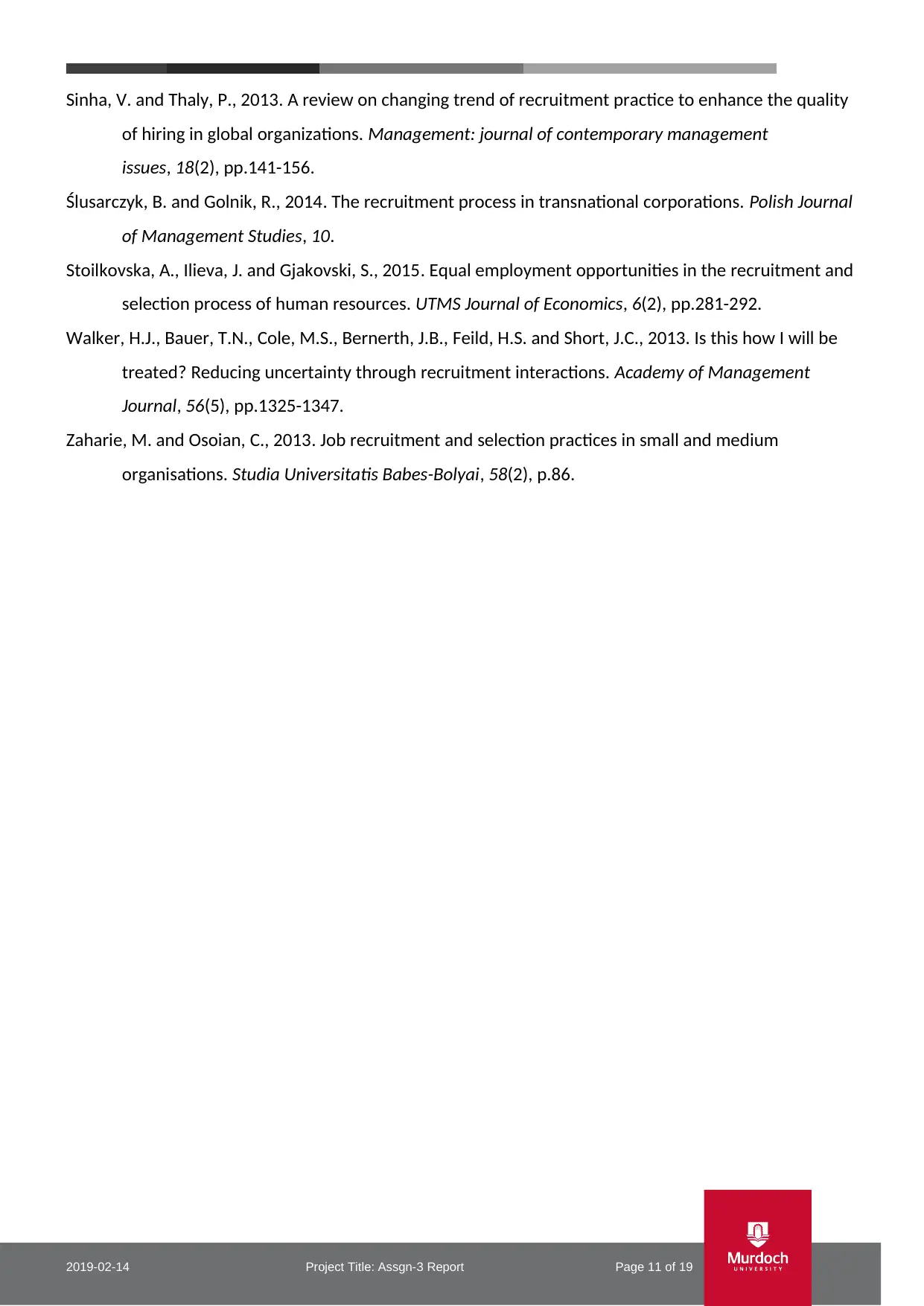
Sinha, V. and Thaly, P., 2013. A review on changing trend of recruitment practice to enhance the quality
of hiring in global organizations. Management: journal of contemporary management
issues, 18(2), pp.141-156.
Ślusarczyk, B. and Golnik, R., 2014. The recruitment process in transnational corporations. Polish Journal
of Management Studies, 10.
Stoilkovska, A., Ilieva, J. and Gjakovski, S., 2015. Equal employment opportunities in the recruitment and
selection process of human resources. UTMS Journal of Economics, 6(2), pp.281-292.
Walker, H.J., Bauer, T.N., Cole, M.S., Bernerth, J.B., Feild, H.S. and Short, J.C., 2013. Is this how I will be
treated? Reducing uncertainty through recruitment interactions. Academy of Management
Journal, 56(5), pp.1325-1347.
Zaharie, M. and Osoian, C., 2013. Job recruitment and selection practices in small and medium
organisations. Studia Universitatis Babes-Bolyai, 58(2), p.86.
2019-02-14 Project Title: Assgn-3 Report Page 11 of 19
of hiring in global organizations. Management: journal of contemporary management
issues, 18(2), pp.141-156.
Ślusarczyk, B. and Golnik, R., 2014. The recruitment process in transnational corporations. Polish Journal
of Management Studies, 10.
Stoilkovska, A., Ilieva, J. and Gjakovski, S., 2015. Equal employment opportunities in the recruitment and
selection process of human resources. UTMS Journal of Economics, 6(2), pp.281-292.
Walker, H.J., Bauer, T.N., Cole, M.S., Bernerth, J.B., Feild, H.S. and Short, J.C., 2013. Is this how I will be
treated? Reducing uncertainty through recruitment interactions. Academy of Management
Journal, 56(5), pp.1325-1347.
Zaharie, M. and Osoian, C., 2013. Job recruitment and selection practices in small and medium
organisations. Studia Universitatis Babes-Bolyai, 58(2), p.86.
2019-02-14 Project Title: Assgn-3 Report Page 11 of 19
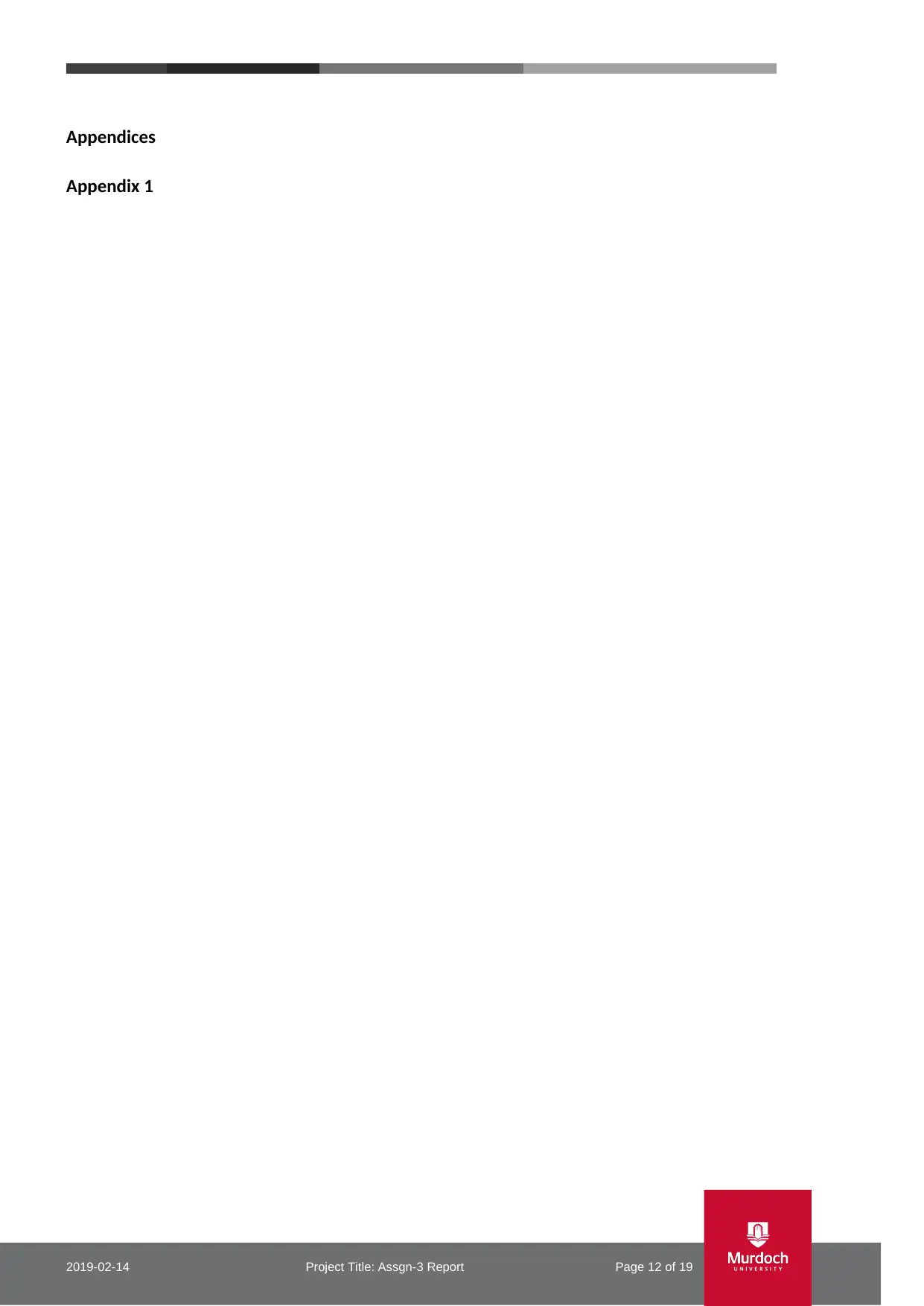
Appendices
Appendix 1
2019-02-14 Project Title: Assgn-3 Report Page 12 of 19
Appendix 1
2019-02-14 Project Title: Assgn-3 Report Page 12 of 19
⊘ This is a preview!⊘
Do you want full access?
Subscribe today to unlock all pages.

Trusted by 1+ million students worldwide
1 out of 19
Related Documents
Your All-in-One AI-Powered Toolkit for Academic Success.
+13062052269
info@desklib.com
Available 24*7 on WhatsApp / Email
![[object Object]](/_next/static/media/star-bottom.7253800d.svg)
Unlock your academic potential
Copyright © 2020–2025 A2Z Services. All Rights Reserved. Developed and managed by ZUCOL.




